Geoff Nicholson's Blog, page 56
December 23, 2015
WALKING INDETERMINATELY, WITH CAGE AND KIRK
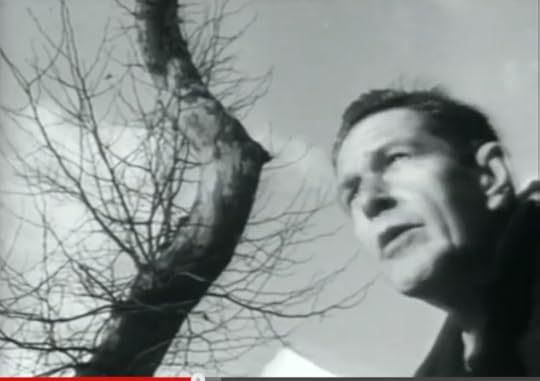
And speaking of John Cage – do you want to see a piece about walking written by John Cage? Well of course you do. It’s from Indeterminacy (and it’s sometimes given more orthodox layout):
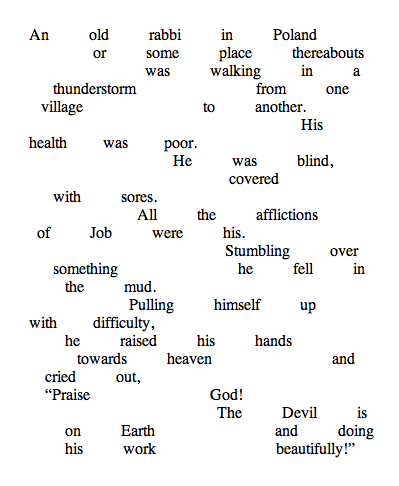
And do you want to to see a picture of the great man walking? Well, why wouldn’t you? This is a still from the 2012 documentary Journeys in Sound.
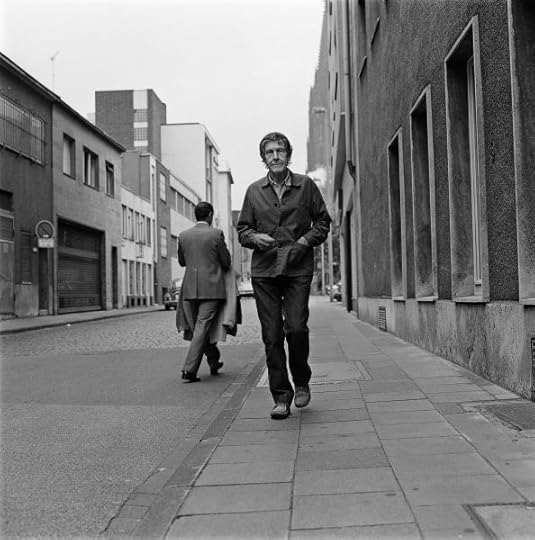
There's a trailer for it here:
I also found an extraordinary, and not entirely easy to watch, documentary titled Sound?? From 1966 or 67 (scholars seem to differ). It’s about Cage and Roland Kirk. There’s a lot of free-blowing from Kirk at Ronnie Scott’s club, and there’s some electronic noise from Cage – and the two do kind of come together.
And we do see them both walking, apparently in London. Kirk walks along causing some (unnecessary) consternation to the passersby.
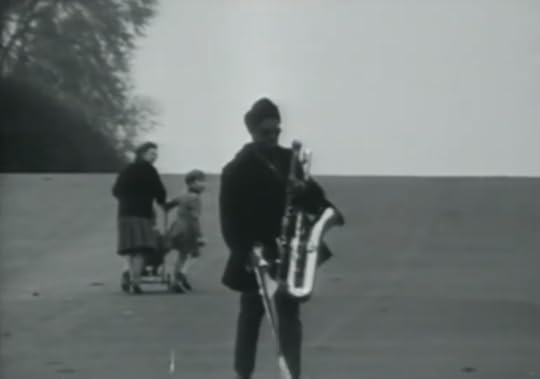
And we see Cage walking in a children’s playground, somewhere near Spitalfields I think, and finally in an anechoic chamber.
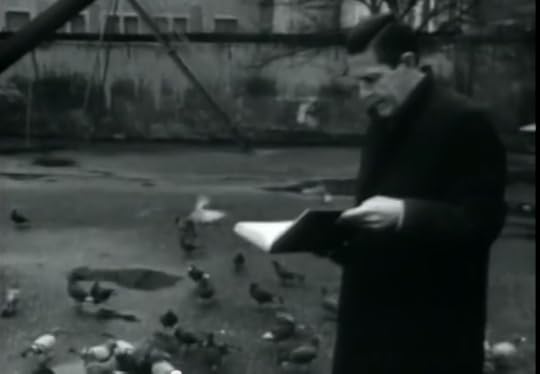
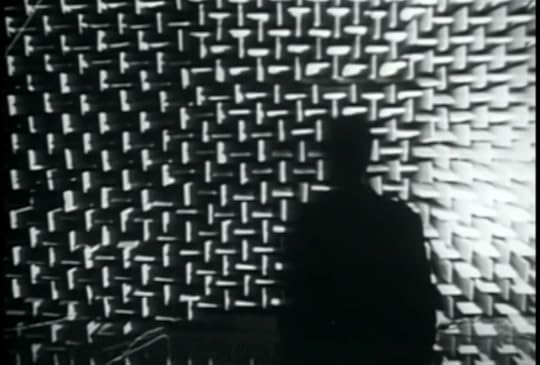

Published on December 23, 2015 17:54
December 17, 2015
ABIDE WITH ME - STREET-STYLE
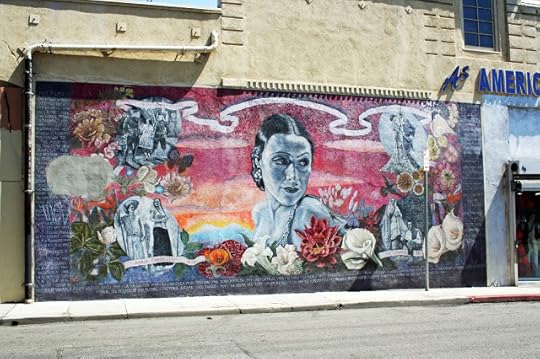
I suppose that if you leave your art out in the street, you can’t be too surprised if it fails to stay pristine. Even so, the last time I walked along Hollywood Boulevard I was surprised, and maybe shocked and offended, and certainly dismayed, to find that the above mural of Dolores Del Rio had been, so to speak, subverted some rather inelegant tagging. It now looks like this:

Well, who could say they were completely surprised? You might think the solution would be to put the art under transparent plastic, but that seems to be only a partial solution. When I was in London earlier this year, wandering around Fitzrovia, I came upon a Banksy; genuine as far as I could tell. It had started out looking like this:
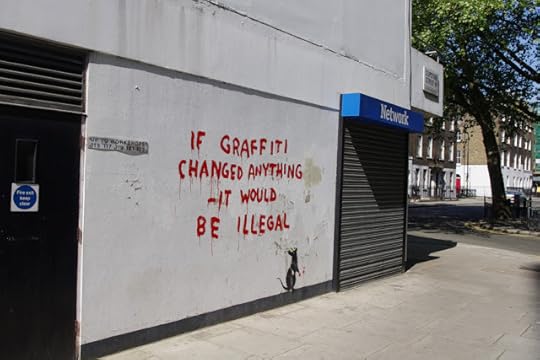
But when I saw it, it looked like this:
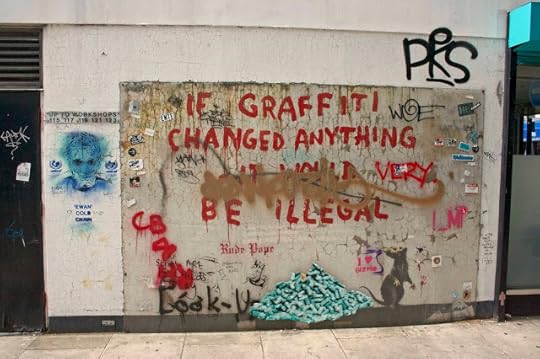
It seems that a certain number of people want to “express themselves” in conjunction with or in opposition to Banksy. In many cases this doesn’t look much different from being jealous and resentful. Arguably the original remains intact but the effect is spoiled, or maybe it isn’t. Banksy is obviously sussed out enough not to be surprised by this kind of thing. Whether that’s the same as welcoming it, I’m not sure.
Want to see an amazingly unconvincing faux Banksy. Then check out this one that was on the front of the Liberal Club in Woking a few years back:

Although of course it does occur to me that it looks so faux that maybe Banksy (subversive that he is) actually did it just to confuse the art lovers and the art haters of Woking.
But sometimes you don’t need human intervention to create change and decay in a mural. Nobody has tagged or vandalized Terry Schoonhoven Isle of California mural in the Sawtelle district of LA , but it’s now the best part of 45 years old. It was created in 1970-2, when it looked like this:
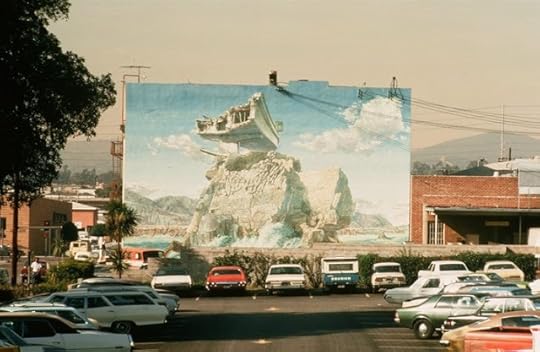
And now it looks like this:
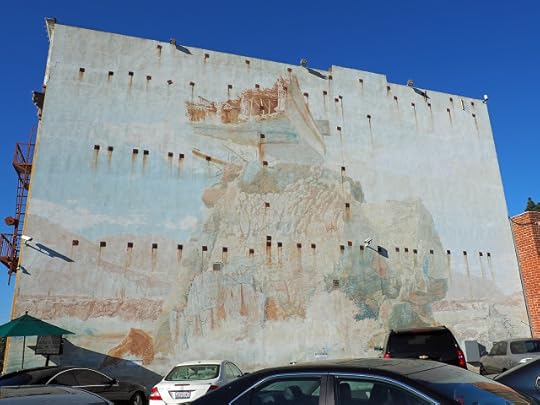
The California sun has been the main agent of destruction here, which again comes as no surprise. But also the wall has been reinforced, which is obviously a good thing – nobody wants the wall to fall down- but the anchors (I think that’s the right term) are evidently made from some kind of ferrous metal, and so each of them has rusted and bled.

As a man who enjoys a little ruin and entropy, as well as art, I find it hard to get too upset about it. I also love walls, whatever state they’re in. Here’s a picture of one I saw earlier, in New York – no sign of rust, but no sign of art either.


Published on December 17, 2015 12:02
December 15, 2015
STREET ART AND SUCH

Sticking with the concept of “where the streets have a name, and a pretty good one at that,” I found myself last Friday in downtown Los Angeles walking the really very short distance between Astronaut Ellison S. Onizuka Street to Traction Avenue. Unlike some fancily named streets there’s plenty of interest in both these places.

Ellison S. Onizuka was an American astronaut of Japanese descent, who was one of the crew of seven who died aboard the Space Shuttle Challenger in 1986. That’s him above, standing beside a model of the shuttle. And here in Astronaut Ellison S. Onizuka Street there’s a very much bigger model:
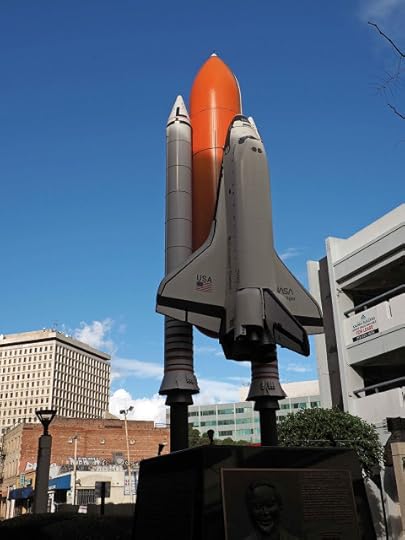
It looks good, even reflected in a puddle in the rain. Yep, it rained in L.A. last Friday:
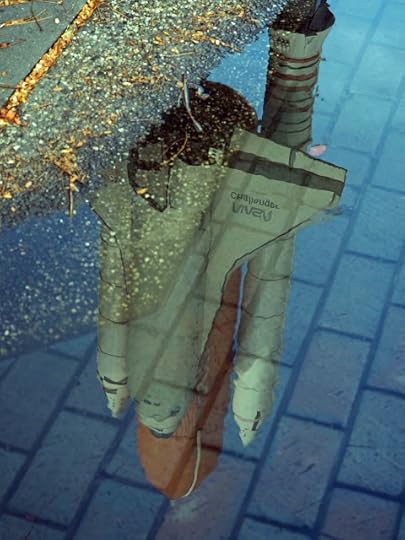
Traction Avenue is in the Arts District, a terrible name for a district if you ask me – as though art needs to be corralled into some ghetto. In any case we’re given to understand that artists can’t afford to live there anymore.Of course the whole area has art coming out its wazoo – graffiti, street art, decorated dumpsters (I intend to publish a short monograph – or at least a blog post - on “the decorated dumpster”) and murals of course. There’s this one of Ai Weiwei:

And I thought this was very fine, and a new one on me, a kind of totem pole made using rubber tires:
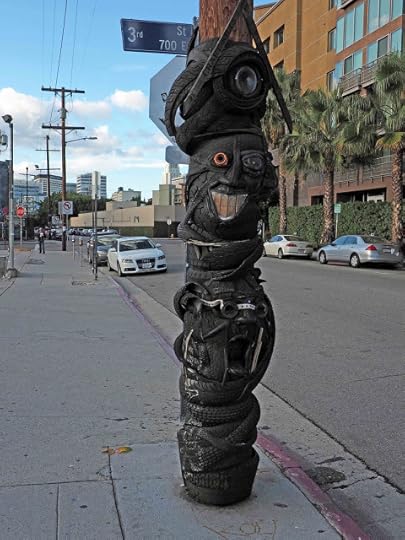

This part of the perambulation was something of a delaying tactic. I was in downtown to take a look at the Triforium, a piece of “polyphonoptic” sculpture, built in 1975, with 1,494 multicolored glass cubes designed to glow in synch with music from a 79-note glass bell carillon. It’s located well outside the Arts District.
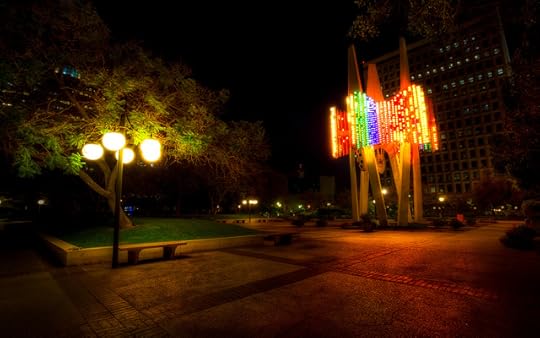
It’s the work of Joseph Young, and it’s located in the unexotically named Fletcher-Bowron Square, and actually sits on top of the incredibly bleak Los Angeles Mall. The mall’s architect Robert Stockwell was responsible for commissioning Young. These days the whole place looks like the mall that time forgot.

I admit that until recently I’d never really been aware of the Triforium, and the Angelinos I’ve talked to, the ones who have any opinion about it at all, seem to regard it as a likeable, though unserious, 1970s folly, and I’ve yet to meet anybody who actually saw it in full functioning son et lumiere mode. It’s certainly been neglected, and by some accounts it never worked properly even from the beginning. It was, arguably, ahead of its time and required some serious computer technology that it didn’t have.

On the other hand, the basic structure seems to be in pretty good shape and if you stand in the right place as the sun is going down you can see those glass cubes glow (kind of), although last Friday the sun was long gone before I got there.


This was a special day for the Triforium, a 40 year anniversary, and there was to be a “launch party” for its restoration. Festivities started at 4 pm, and when I arrived, at 4.30 or so, a dj was laying down some cosmic space rock but the Triforium itself was unlit. I assumed they were keeping it this way so that at some point it could be turned on, lit up and the music would be pumped through it. Was this terribly naïve of me? Perhaps, but I wasn’t alone in my foolish hopes.
Some official-looking young uns were sitting at a table in the square, and from time to time people would come up to them and say, “So when do you fire it up?” And the reply was that they weren’t going to fire it up. The Triforium doesn’t work, not the sound, not the lights, nuthin. Which was why they were having a fundraiser. Oh. I was not alone in my disappointment.
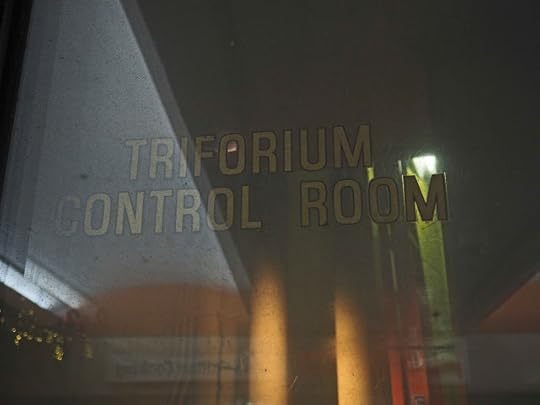
But at least I did get to step into the Triforium control room. It all looked very Cold War. The guy there said they’d had in various electricians and computer guys and none of them could make the thing work, and as far as I could tell they didn't know how it had ever worked. But as one of my fellow visitors pointed out, the system must be in some sense “on,” since there are glowing lights, so obviously there’s power getting in there, and somebody must be paying the electricity bills. How does that work? I have no idea.
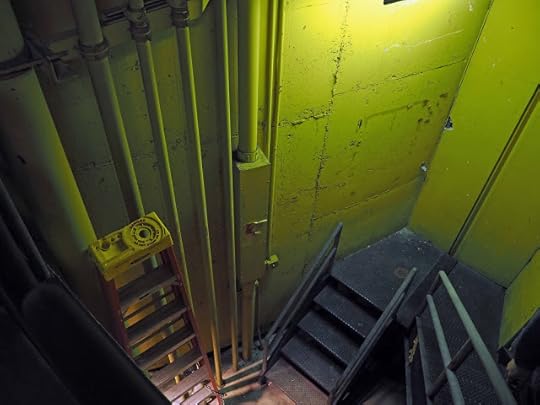

Among the crowd was top LA photographer and visual chronicler Gary Leonard, a pleasantly chatty man, and he said he’d been there in 1978 for John Cage’s 75th birthday party. Did Cage perform or conduct or use the Triforium in some way, I asked. Maybe 4'33'? No, said Gary, but there was cake:
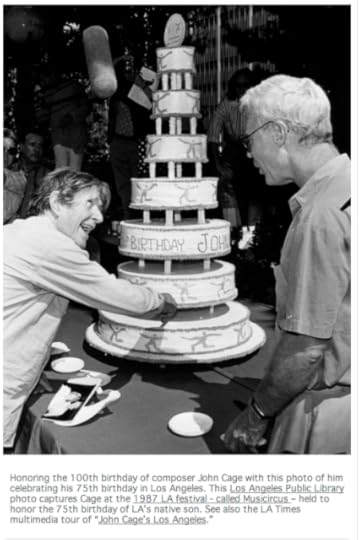
As I slipped away the Triforium looked like this:

The Triforium Project website is here:
http://triforium.la

Published on December 15, 2015 10:03
December 8, 2015
LIGHTS ON FOR THE TERRITORY
Meanwhile while drifting in East Hollywood in December …
Is it just me or is there always something incredibly melancholy and mysterious about seeing abandoned women’s shoes lying in the street, whether singly or in pairs? You assume there always has to be a story there, and depending on your taste in stories it may be incredibly banal – woman finally got fed up with her fancy shoes, found them too painful, decided to throw them away – and maybe she had a pair of sensible shoes with her. Or maybe it's evidence of some noirish narrative – a chase through the night, escaping from real or imagined demons, shoes cast aside to increase mobility.
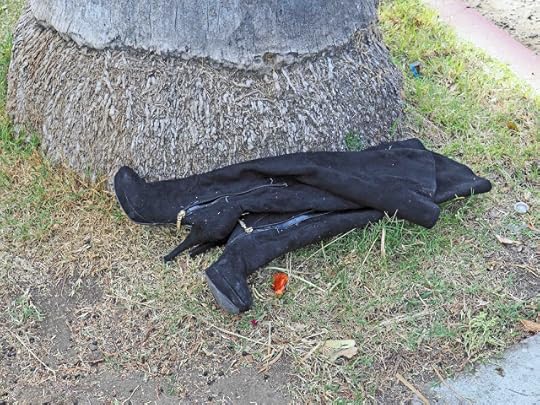
So what’s the story with these rather elegant, and as far as I could tell, perfectly serviceable black suede, high-heeled boots that had been carefully placed at the base of a tree? A gift to the neighborhood? They were certainly gone when I walked by again later in the day.
Of course it goes dark early in Hollywood these day. When I first arrived here a decade or so ago it seemed that the neon of Hollywood was something very spectacular. I seem to think there were organized bus tours. Now I either don’t see it or the whole neon thing has dimmed. Consider the Hollywood Downtowner Motel, which in neon form has become the Hollywood Downtowner Mo. Is that a joke?
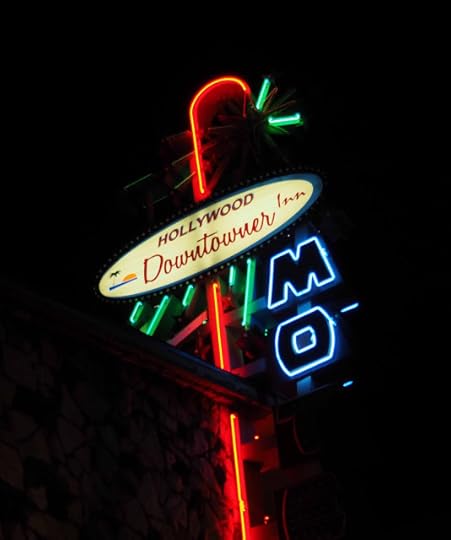
And just round the corner from there one of the apartment buildings has decided to make it a prehistoric Christmas. I think this is just wonderful, while also being fairly glad that I don’t live in the building next door.



Published on December 08, 2015 09:51
December 6, 2015
THE STREET WHERE SOMEBODY OR OTHER LIVES
My upbringing was both weird and boring. And one of the weirdnesses was that I’ve ended up with a strangely extensive knowledge of the lyrics of dreary show tunes. (Stick with me here.)
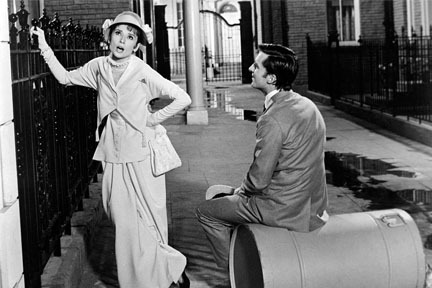
And some of the lyrics that always confused me as I was growing up were in the song “On The Street Where You Live.” It’s by Lerner and Lowe, from My Fair Lady though I didn’t know that at the time. Lyrics run:
I have often walkedDown the street before,But the pavement alwaysStayed beneath my feet before.All at once am ISeveral stories high,Knowing I'm on the street where you live.
I was baffled – because all the streets I knew consisted of two up, two down terraced houses. If you were “several stories high” you’d be floating around somewhere up above the rooftops. What was good about that? What street DID this woman live on?
In fact the only people I’d ever met who didn’t live in a terraced house were Uncle Oliver and Aunty Kath who lived in this block of flats in Hillsborough, in Sheffield. It’s Regent Court, now regarded as a classic of (admittedly rather watered down) modernism.
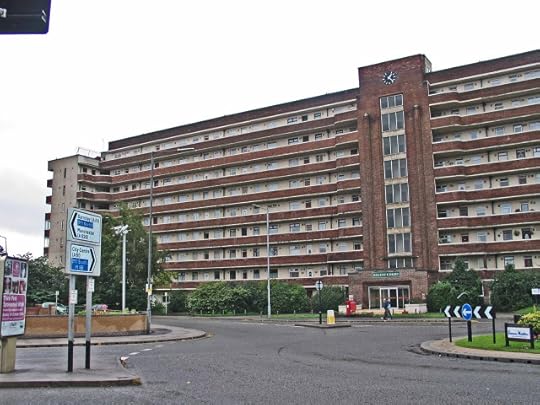
It was built just before the war, and during the Sheffield Blitz people used to run there to take shelter, because metal plates were supposedly used in its construction, and it was therefore safe. I only ever had my mother’s word for this.
If you walked a few hundred yards from Regent Court you’d be in Penistone Road, and it says much for the innocence of those times that nobody I knew ever referred to in as Penis-tone Road, which everybody surely would these days.
In Hillsborough there was also Dyke’s Hall Road, though as far as I knew there was no dyke. And for that matter there was Swamp Walk, again with no evidence of a swamp.
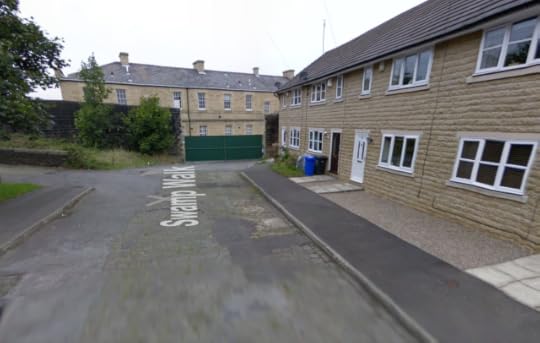
But I suppose it’s in the nature of being a kid that you accept whatever’s in front of you, and I walked those streets without much surprise or curiosity about the names. Well, times and sensibilities change.
The fact is – and I admit this is not a very serious psychogeographic reason for walking anywhere – I find there is a certain thrill that comes from walking along a street with a cool or odd or curious name, even if the street itself is fairly ordinary.
I can hardly tell you how much I enjoyed walking along Tinderbox Alley in Mortlake:
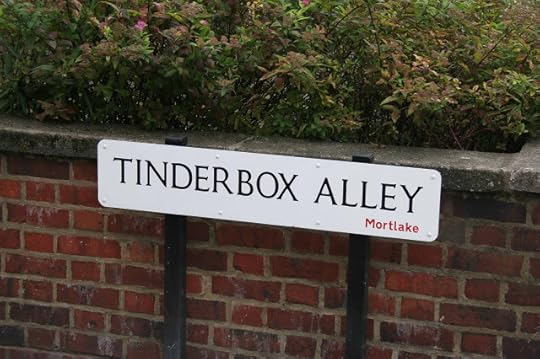
And in Lewisham, there's the very wonderful-sounding Fossil Road – it did no harm that the street sign itself looked a bit fossilized.
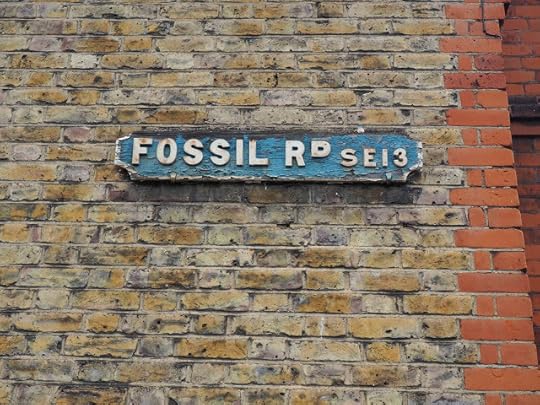
Walking anywhere in Guadalajara was pretty interesting, but things perked up even more when I got to walk along Cometa, Astros, Atmosfera, Nebulosa:
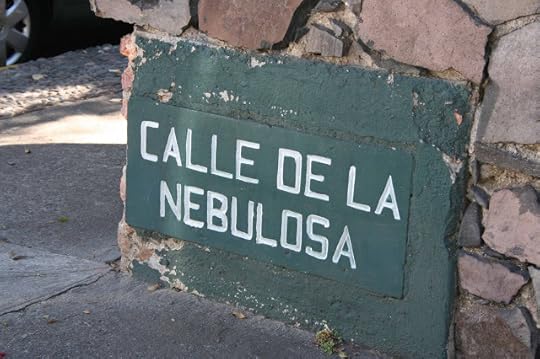
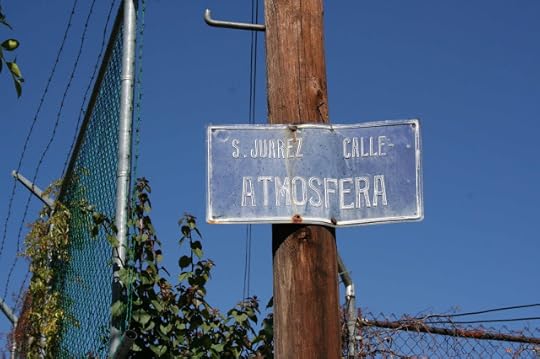

And right now this is my current favorite – Uranium Avenue, in Moab, in Utah:

I did walk along it earlier this year, and it was a very ordinary street to walk on, no evidence of uranium, running between a supermarket and a tourist information center, but even so wouldn’t it be great to be able to say this was the street where you lived?
*
Oh and just so we don’t forget that this is in fact the Hollywood Walker, here’s Cosmo Street – a very short street that runs south off of Hollywood Boulevard. I’d lived here for years and walked along Hollywood Boulevard scores of times before I noticed it.
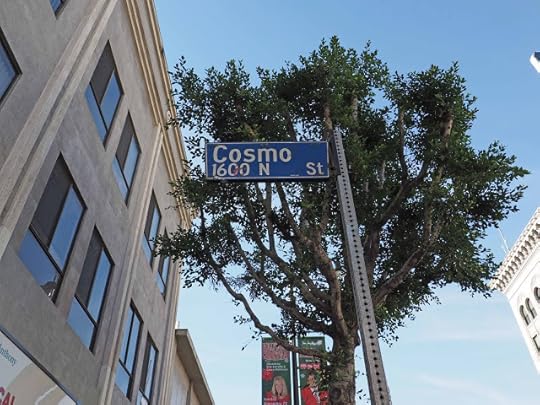

Published on December 06, 2015 17:22
February 4, 2013
THE QUESTION EVERYBODY’S ASKING

The
question is this: “But is it safe to wear high
heels when exercising?” Don’t ask me, I
haven’t a clue, but Elise Sole (a made up name surely) has some answers on
shine.com. in an article headlined "Would You Exercise in High Heels?" You can look it up, I'm sure. She certainly doesn't seem to regard walking as exercise.
She tells us about a class taught by certified (in
some sense anyway) fitness instructor Kamilah Barrett, 35, called “Heel Hop” “a no-impact hour of strength-training that
helps women develop cardio vascular strength and the confidence and skill to
rock high-heeled shoes.” Yes, it’s the
lack of confidence that’s really the root of the problem, I expect.
Then there are Stiletto Fitness Classes in Kansas City,
M.O. "core and lower body high-impact strength and training fitness
class." That’s high impact as opposed to no impact. “Created by former dancer Coryelle Abney in
July 2012, her class helps women look graceful wearing heels while offering a
serious calorie burn.” No downside to
that.
But then of course a doctor gets dragged in, Dr.
Elisa M. Kavanagh, DPM, who treats the New York City Rockettes. She says, "I
wouldn't advise women to bring their Jimmy Choos to a class like this. If you're curious, wear character shoes (they
look like a classic Mary Jane with a chunky heel) that are flexible and
designed for stomping, kicking, and twirling.” I see: character shoes with a chunky heel. You haven't quite grasped this concept, have you doc?
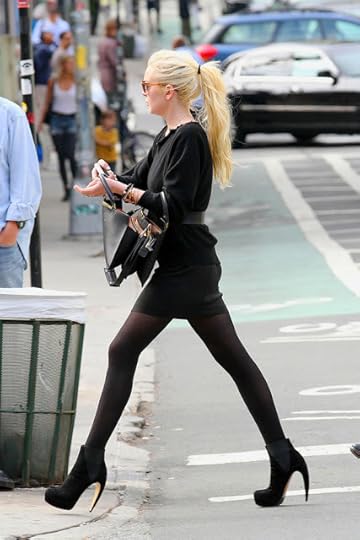
And above, for no very good reason, is Lindsay
Lohan – I’ll bet she does a lot of things in high heels that aren’t entirely
safe, walking being one of them.

Published on February 04, 2013 17:03
January 22, 2013
THE LAST PSYCHOGEOGRAPHER ON EARTH

I’ve been thinking about Immanuel Kant, author of The Critique of Pure Reason, and Charlton Heston, star of
The Omega Man.
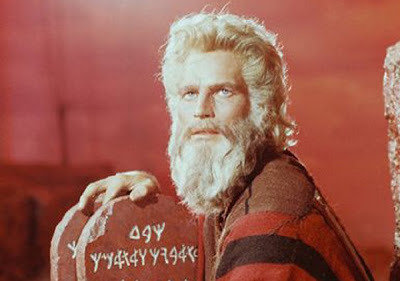
Immanuel Kant, 1724 – 1804, lived his whole life in Konigsberg, in
Prussia, what is now Kaliningrad, in Russia. He was man
of rigorous habits and walked every day as he thought and philosophized. So regular were these walks that people said
you could set your clock by the time Kant strolled past, even though there
seems to be no absolute agreement about exactly where he walked.
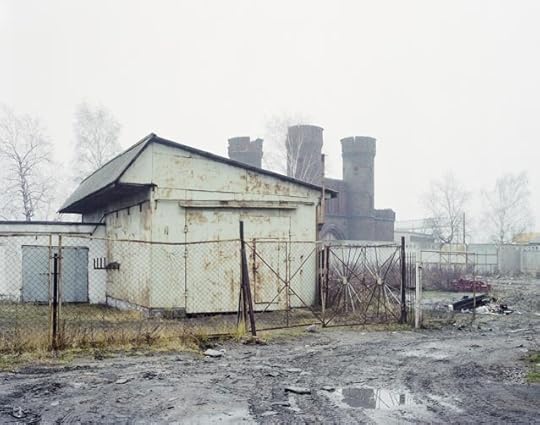
In the early 2000s an artist named
Joachim Koester created The Kant Walks,
doing his best to plot and then walk Kant’s route or routes. The proposition
was made trickier given that large parts of the city were destroyed by Allied
bombing at the end of World War Two, and the center was never rebuilt. Koester took some gorgeously bleak
photographs along the way.

Koester writes, “… Kant’s walk is
often invoked but rarely specified. A
walk is like a manual, a way to engage in space, a recipe to follow but also to
improvise with, allowing for drifting, losing oneself.”
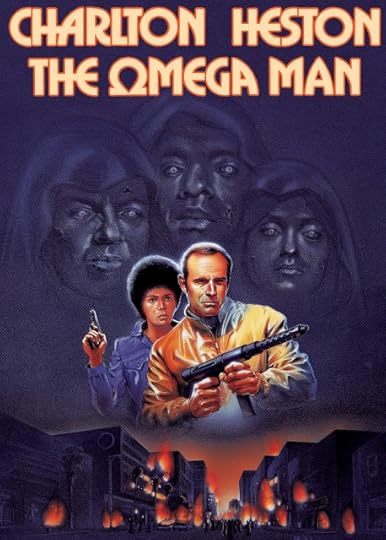
And so, at the end of last week I found
myself in downtown Los Angeles drifting and improvising, trying to follow in
some of the footsteps of Charlton Heston, as taken in the The Omega Man, based on Richard Matheson’s novel I Am Legend. Charlton, playing Robert Neville, is nearly
but not quite the last man on earth, but most of the ones that remain are zombie-ish
vampires (they walk like zombies, but they can be killed like vampires).
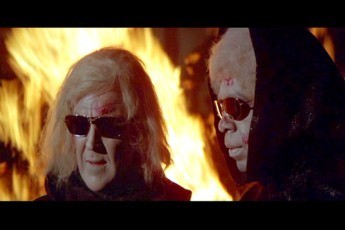
Tracking Charlton Heston is certainly easier
than tracking Kant, not least because one or two online movie obsessives have
already done some of the spade work. Everyone
says how much downtown LA has been revitalized but there are still some amazing
pockets of neglect and desolation. I
happened to walk along Skid Row, and amid the many homeless people there was an
old black man with dreadlocks who was carrying a hammer, and thought that the
tarmac of the road needed a lot of hammering, which he duly delivered.
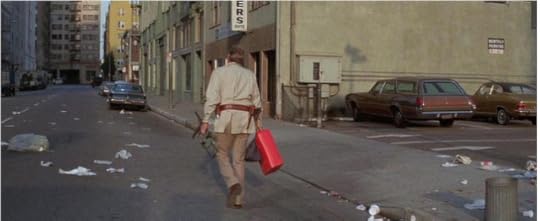
Above is Charlton Heston walking along Santee
Street, and below is the street as it is is today.
Some buildings are gone, some spruced up, but the basic structure is perfectly
recognizable from the movie. This is the building at the end of the street that Heston's walking towards.

Then there’s the Olympic movie theater where
Heston goes repeatedly to watch Woodstock
(your guess is as good as mine).
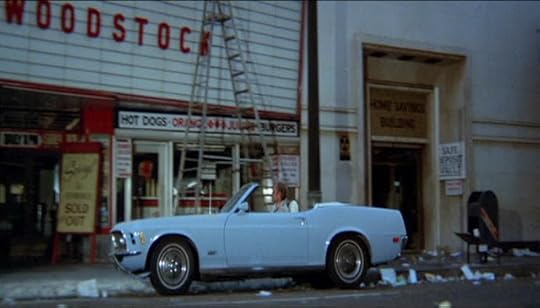
Not sure if the resolution's good enough, but there's a fallout shelter sign to the
right of the theater;s frontage. The place is now
a store selling elaborate decorative furnishings - complete with a sign that says everything must go – but the part where movie titles could de displayed
is still intact.
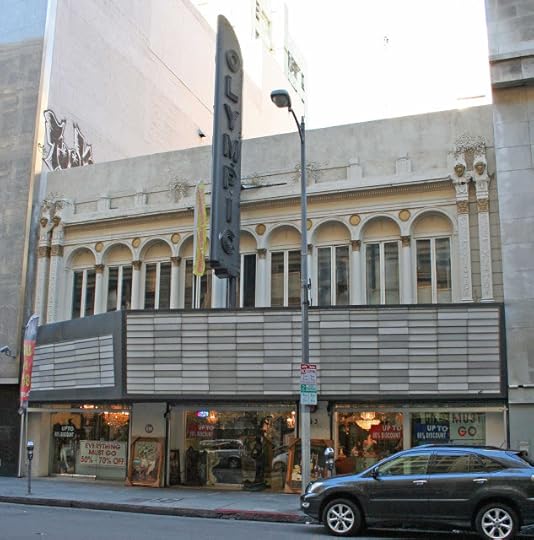
And here, not very far away, is a
remnant from a now closed down jewelry store, once so successful they could
even replace the sidewalk. I'd definitely have had that in the movie.
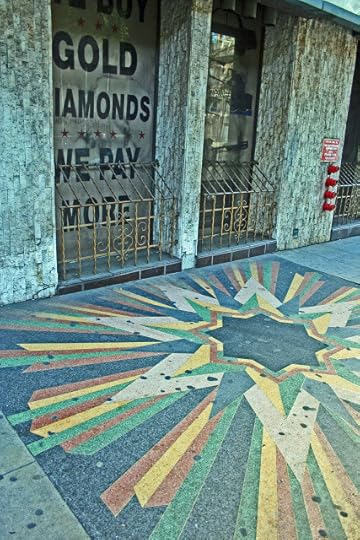
And then, completely untouched as far as I could tell, exactly as in the movie, although with new buildings in the distance, is the Water and Power building at First Street and Hope.
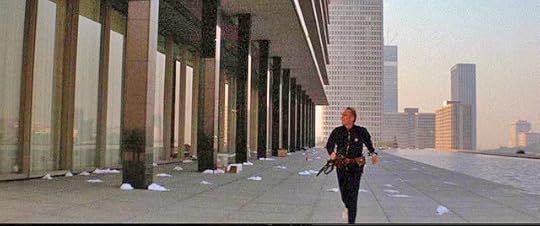
It’s hard to see the building from many of the surrounding streets because
it’s right behind Gehry’s Disney Hall, and of course in the normal run of
events, you’re not likely to go there unless you have some business concerning
water and power. However, and this is truly
a wonder, the building is surrounded by water – it’s MOATED – with a bridge,
though not a drawbridge as far as I could tell.

At the end of the afternoon I went into
the Last Book Store, a huge and I hope not doomed enterprise, and found a used copy
of The Image Of The City by Kevin
Lynch, a 1960s city planner, and a pioneer of one psychogeography according to some sources, a book which contains this terrific passages: “It must be granted that there is some value
in mystification, labyrinth or surprise in the environment ... This is so,
however, only under two conditions.
First, there must be no danger of losing basic form or orientation, of
never coming out … Furthermore, the labyrinth or mystery must in itself have
some form that can be explored and in time be apprehended. Complete chaos without a hint of connection
is never pleasurable.” Something I
suspect that we could all agree on, Imannuel Kant and Charlton Heston,
included.


Published on January 22, 2013 11:39
January 16, 2013
LE MARCHEUR DE HOLLYWOOD
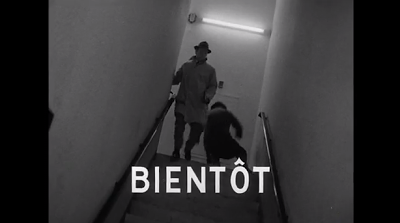
It’s got to be difficult to be French, hasn’t it? What do they call “film noir” for instance? “Black Cinema” just doesn’t cut it. And you can see why they’d want to reclaim
the term for the French movie industry, but when the French try to make a native
film noir, it always ends up looking, forgive me, a little too French.
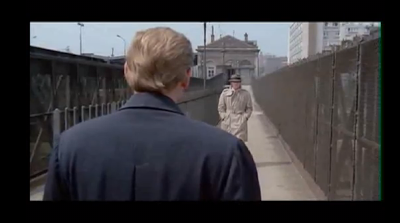
This crass overgeneralization comes as a result of having watched Jean-Pierre
Melville’s 1967 movie Le Samouraï over the weekend. It has Alain Delon, with fedora, trench coat,
gun, and occasionally white gloves, being extraordinarily insouciant and Gallically
engaging, but also utterly unconvincing as an assassin. You’re not sure if you want to hit him or
kiss him – I’ll bet he gets a lot of that.
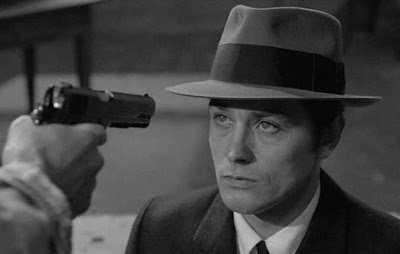
Even David Thomson, in the handy little booklet that comes with the DVD,
has his reservations. He calls the movie great but says it’s “poised on the
brink of absurdity, or a kind of attitudizining male arrogance.” Some of course might say it’s gone over the
brink. But it does have a fair amount of elegant walking in it.
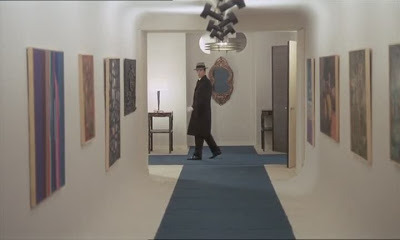
The movie is famous, at least in some quarters, because of a
brilliantly original chase scene, not involving cars but using the Paris Metro. In a book titled Atlas of Emotion Giuliana Bruno makes a great deal of this subway chase. She writes, “from the ruins of film noir, a
story about mapping emerges ... Here, we engage in the very flux of
psychogeography. Our hero knows his city
“intimately”; that is, he knows all its inner workings. He has internalized the subway map … So
familiar is streetwise Delon with this map that he can move jointly with it.”
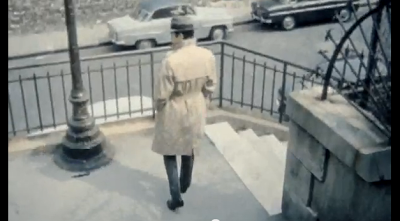
Well yes, OK, sort of. Ms. Bruno
is also responsible for a book titled Streetwalking
On a Ruined Map – which is a title so wonderful that I’m not sure any book
could ever possibly live up to it.
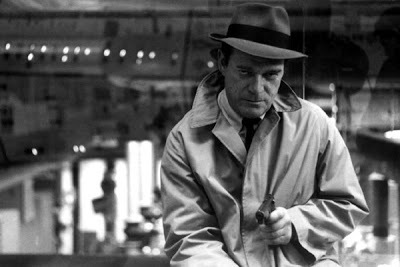
It’s pretty hard, for me anyway, to watch Le Samouraï and not think of Jean Luc Godard’s Alphaville, made a couple of years
earlier, which is also “poised on the brink of absurdity” but it helps a lot
that Eddie Constantine looks more like a bullfrog than a pretty boy. It’s a long time since I saw it, and I wish I
remembered it better, and to be honest I can’t tell you whether it involves
much walking or not. But if the stills
are to believed there’s certainly some film noir strutting and posing, and I
dare say some attitudizining male arrogance.
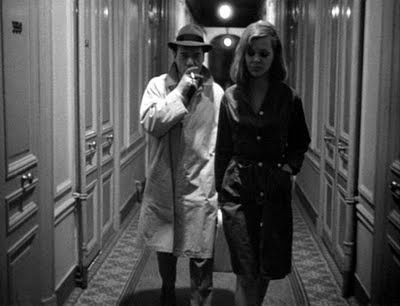
And finally a more or less current picture of M. Delon. Still walking, still French, but just a little less insouciant.


Published on January 16, 2013 08:41
January 10, 2013
BAD WALKING MEN
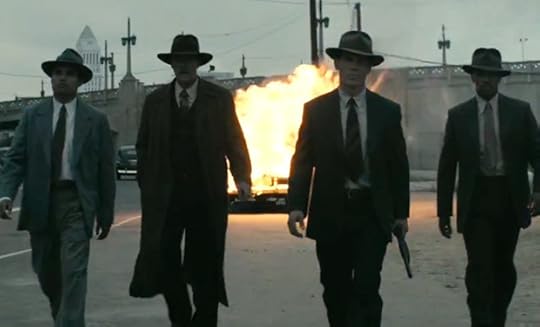
I seem to have seen more than the usual numbers of trailers for the new
movie Gangster Squad, which may mean
that the movie’s very good, or it may mean it’s very bad – large amounts of
bought publicity attach to both. Either
way, there seems to be something all too familiar about the way it’s being sold:
lots of images of dangerous looking men walking (or I dare say striding or
strutting) across the screen or into the camera.
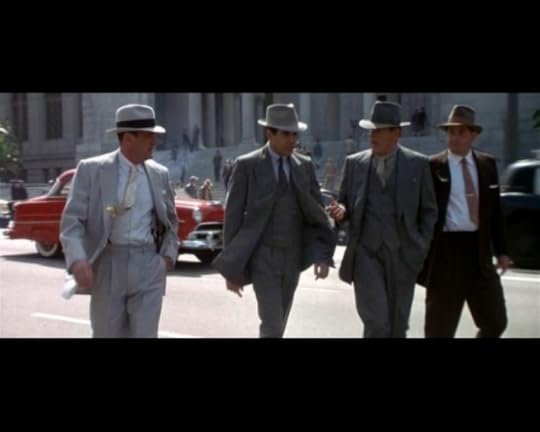
We’ve seen a lot of this before haven’t we? If we’ve seen Mulholland Falls we’ve already seen Nick Nolte, who actually appears
in Gangster Squad, doing something
very similar indeed.
If you saw any of these guys walking down the street towards you, you’d cross
the street to avoid them right? The fact
that they’re cops, that they’re morally ambiguous, but they’re more or less on
our side, really doesn’t make any difference, does it?
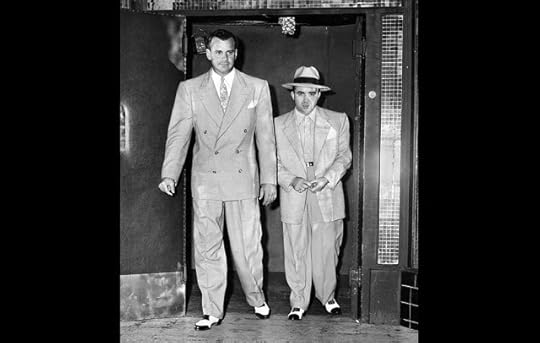
Gangster Squad is
based on a “true” story - which somebody, somewhere, decided long ago was a
selling point for a movie – and it deals with the take down of gangster Mickey Cohen. There’s no denying that Cohen was a very bad guy,
but as a walker, above on the right, he just didn’t have that dangerous, threatening stride.
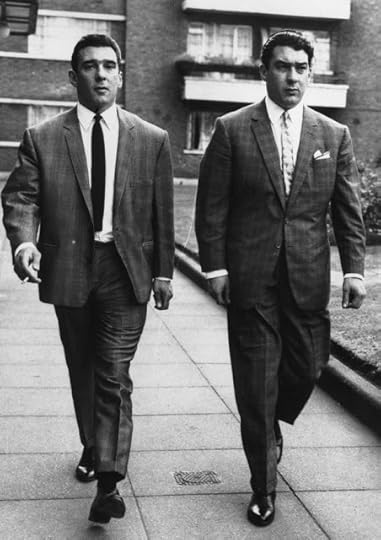
Compare and contrast with the Kray brothers. If you saw these two psychos walking towards you, you wouldn’t just cross the street - you’d leave the neighbourhood.

Certain kinds of rock band have always liked to employ a dangerous
strut, or swagger, as well as a bit of moral ambiguity. For me there’s always been some serious disconnect
between the image and the reality of the Clash, but there’s no denying they
looked and dressed the part, above.

And finally this image, by Terry O’Neill, of Chairman Frank
Sinatra, accompanied by admittedly fringe members of his “board.”
To some eyes, this picture shrieks “links to organized crime,” though defenders
say no, no, he’s actually with his stunt double, his bodyguard, his personal assistant
and the film set's head of security,
who was an ex-cop. The fact these guys
just happen to look like mobsters is a complete accident.
And even if
Sinatra’s guys are complete softies, the image still delivers the same message:
“I’m walking here, get out of my way.” And you can see in the picture that everybody has.
“Your way Frank, sure.”

Published on January 10, 2013 17:33
January 8, 2013
THE WALKING CAMERA
If I look up from my desk and peer across the room, my eyes inevitably
fall on a poster of one of my favourite images by one of my favourite
photographers. It’s Garry Winogrand’s image
two women at LAX airport walking toward what’s known as the Theme Building. It looks like this:
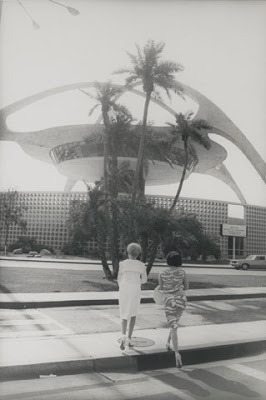
In fact Winogrand is responsible for a great many of my favourite photographs. He was, I suppose you’d say, a street
photographer, and in the course of his profession he did a lot of walking and
photographed a lot of other walkers. He’s
usually associated with New York, but he took a lot of pictures in LA.
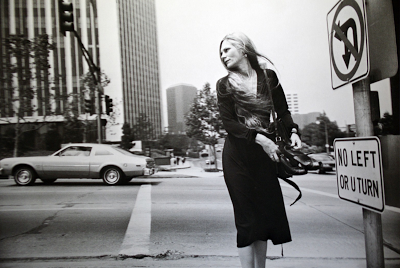
He even took, and even some in London.
The received wisdom is that his London photographs weren’t as good as
his American ones, that his skill was to see a familiar environment with fresh
eyes: when confronted by an unfamiliar environment this freshness disappeared
and he was reduced to taking pictures of guardsmen or men in bowler hats. Still, I’m very taken by the odd familiarity
and strangeness of this one, titled Woman
Entering a Cab, London.
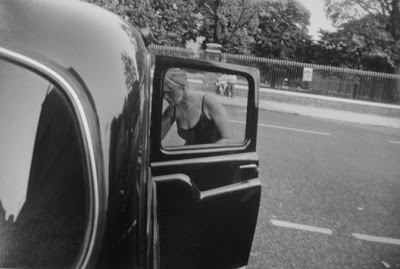
Winogrand did like shooting women in the street, so to speak, which in
these days of the demonized male gaze seems a dodgy activity at best, but hell
he had nothing on Miroslav Tichý. I love Geoff Dyer’s description of Tichý’s working method, “he spent his time perving around Kyjov, photographing women.” Well yes
indeed. I suppose Winogrand’s method was
less pervy because it was less sneaky, though I know there are those who’d find
this an overfine distinction.

Street photography has been much on my mind lately, having been
hunkered down with Reuel Golden’s London:
Portrait of a City, a grand photobook, showing London, its people and
inevitably its walkers. Full disclosure: I am mentioned approvingly therein. One picture that
particularly stays with me, is the one below by Cecil Beaton, not really pervy
I suppose, since it’s obviously a set up with a model, and because the
photographer’s perviness was directed elsewhere.
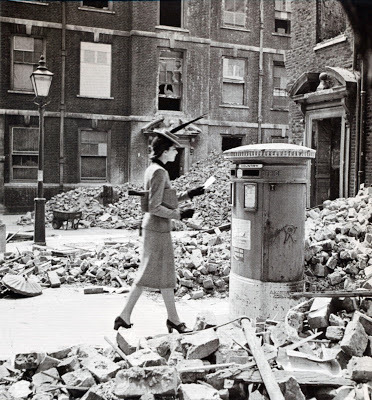
I like taking pictures, I do it all the time, and I’m a good enough photographer to
know I’m not a very good photographer. But once in a while I take a photograph
that makes me happy. Here is the best
walking I've taken in a very long time. Garry
Winogrand, it know it ain’t.
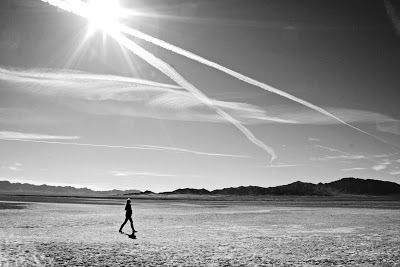

Published on January 08, 2013 14:40
Geoff Nicholson's Blog
- Geoff Nicholson's profile
- 55 followers
Geoff Nicholson isn't a Goodreads Author
(yet),
but they
do have a blog,
so here are some recent posts imported from
their feed.



